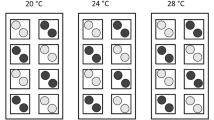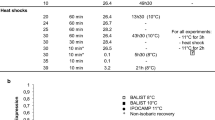Abstract
Physiological studies have long been utilized to understand the role of environmental temperature in the distribution of native organisms within marine communities. For the invasive crab Carcinus maenas, temperature has been implicated as the main predictor of establishment success across temperate regions. Therefore, we determined whether the lower temperature tolerances of this non-native crab would restrict it from spreading farther poleward from a relatively new recipient environment. Cold tolerance capacity was determined in the laboratory by holding crabs sampled from Vancouver Island, British Columbia (BC)—near the present northern limit for the northeast Pacific metapopulation to an overwintering thermal profile generated from Sitka, Alaska, USA. These crabs were physiologically capable of overwintering north of their present range boundary. The cellular response to cold stress was investigated using two functional categories of the cellular stress response. We measured cyclin D1, a cell-cycle regulator, and Hsp70, a protein chaperone, after laboratory acclimation and acute cold stress on two populations of C. maenas from the west coast of North America that have disparate thermal histories (crabs sampled from CA or BC). We found site-specific differential expression of cyclin D1 after cold acclimation and cold shock, perhaps affecting invasion capacity in this species. Determining what physiological mechanisms are in place with respect to thermal tolerance and preference can give insight into what makes an invasive organism successful and aid in predicting probable distribution of such species within a new environment.






Similar content being viewed by others
References
Addo-Bediako A, Chown SL, Gaston KJ (2000) Thermal tolerance, climatic variability and latitude. Proc R Soc Lond B Biol Sci 267:739–745
Ali KS, Dorgai L, Ábrahám M et al (2003) Tissue- and stressor-specific differential expression of two hsc70 genes in carp. Biochem Biophys Res Commun 307:503–509
Audet D, Miron G, Moriyasu M (2008) Biological characteristics of a newly established green crab (Carcinus maenas) population in the southern Gulf of St. Lawrence, Canada. J Shellfish Res 27:427–441
Behrens Yamada S, Hunt C (2000) The arrival and spread of the European green crab, Carcinus maenas, in the Pacific Northwest. Dreissena 11(2):1–7
Bin B, Wei-Hua X (2011) Identification of gene expression changes associated with the initiation of diapause in the brain of the cotton bollworm, Helicoverpa armigera. BMC Genomics 12:224–237
Brown JH, Stevens GC, Kaufman DM (1996) The geographic range: size, shape, boundaries, and internal structure. Ann Rev Ecol Sys 27:597–623
Buckley BA (2011) Acute heat stress and thermal acclimation induce CCAAT/enhancer-binding protein delta in the goby Gillichthys mirabilis. J Comp Physiol B 181:773–780
Carlton JT, Cohen AN (2003) Episodic global dispersal in shallow water marine organisms: the case history of the European shore crabs Carcinus maenas and C. aestuarii. J Biog 30:1809–1820
Casanovas O, Miró F, Estanyol JM et al (2000) Osmotic stress regulates the stability of cyclin D1 in a p38 SAPK2-dependent manner. J Biol Chem 275:35091–35097
Compton TJ, Leathwick JR, Inglis GJ (2010) Thermogeography predicts the potential global range of the invasive European green crab (Carcinus maenas). Divers Distrib 16:243–255
Cox G, Moseley P, Hunninghake GW (1993) Induction of heat-shock protein 70 in neutrophils during exposure to subphysiologic temperatures. J Infect Dis 167:769–771
Crozier L (2003) Winter warming facilitates range expansion: cold tolerance of the butterfly Atalopedes campestris. Oecologia 135:648–656
Crozier L (2004) Warmer winters drive butterfly range expansion by increasing survivorship. J Ecol 85:231–241
Darling JA, Bagley MJ, Roman JOE et al (2008) Genetic patterns across multiple introductions of the globally invasive crab genus Carcinus. Mol Ecol 17:4992–5007
de Rivera CE, Hitchcock N, Teck S et al (2007) Larval development rate predicts range expansion of an introduced crab. Mari Biol 150:1275–1288
de Rivera CE, Steves BP, Fofonoff PW et al (2011) Potential for high-latitude marine invasions along western North America. Divers Distrib 17:1198–1209
Feder ME, Hofmann GE (1999) Heat-shock proteins, molecular chaperones, and the stress response: evolutionary and ecological physiology. Ann Rev Phys 61:243–282
Fink AL (1999) Chaperone-mediated protein folding. Physiol Rev 79:425–449
Frederich M, O’Rourke MR, Furey NB et al (2009) AMP-activated protein kinase (AMPK) in the rock crab, Cancer irroratus: an early indicator of temperature stress. J Exp Biol 212:722–730
Fu M, Wang C, Li Z et al (2004) Minireview: cyclin D1: normal and abnormal functions. Endocrin 145:5439–5447
Fujita J (1999) Cold shock response in mammalian cells. J Mol Micro Biot 1:243–255
Guo Z, Wang J, Yang J et al (2009) An inhibitory role of p53 via NF-κB element on the cyclin D1 gene under heat shock. Biochim Biophys Acta(BBA)—Gene Reg Mech 1789:758–762
Han SI, Oh SY, Jeon WJ et al (2002) Mild heat shock induces cyclin D1 synthesis through multiple Ras signal pathways. FEBS Lett 515:141–145
Henkel SK, Hofmann GE (2009) Differing patterns of hsp70 gene expression in invasive and native kelp species: evidence for acclimation-induced variation. In: Borowitzka MA, Critchley AT, Kraan S, Peters A, Sjøtun K and Notoya M (eds) Nineteenth International Seaweed Symposium. Springer, Netherlands, pp 465–474
Hofmann GE, Buckley BA, Airaksinen S et al (2000) Heat-shock protein expression is absent in the antarctic fish Trematomus bernacchii (family Nototheniidae). J Exp Biol 203:2331–2339
Holland DB, Roberts SG, Wood EJ et al (1993) Cold shock induces the synthesis of stress proteins in human keratinocytes. J Investig Dermatol 101:196–199
Jost J, Podolski S, Frederich M (2012) Enhancing thermal tolerance by eliminating the pejus range: a comparative study with three decapod crustaceans. Mari Ecol Progr Ser 444:263–274
Kelley AL, de Rivera CE, Buckley BA (2011) Intraspecific variation in thermotolerance and morphology of the invasive European green crab, Carcinus maenas, on the west coast of North America. J Exp Mari Biol Ecol 409:70–78
Kültz D (2003) Evolution of the cellular stress proteome: from monophyletic origin to ubiquitous function. J Exp Biol 206:3119–3124
Kültz D (2005) Molecular and evolutionary basis of the cellular stress response. Ann Rev Phys 67:225–257
Laios E, Rebeyka IM, Prody CA (1997) Characterization of cold-induced heat shock protein expression in neonatal rat cardiomyocytes. Mol Cell Biochem 173:153–159
Meehl GAST, Collins WD, Friedlingstein P, Gaye AT et al (2007) Global climate projections. In: climate change 2007: The physical science basis. Contribution of Working Group I to the Fourth Assessment Report of the Intergovernmental Panel on Climate Change. Cambridge University Press, Cambridge
Morgan DO (1997) Cyclin-dependant kinases: engines, clocks, and microprocessors. Ann Rev Cell Dev Biol 13:261–291
Nitta M, Okamura H, Aizawa S et al (1997) Heat shock induces transient p53-dependent cell cycle arrest at G1/S. Oncogene 15:561
Ohnishi T, Wang X, Ohnishi K et al (1998) p53-dependent induction of WAF1 by cold shock in human glioblastoma cells. Oncogene 16:1507
Parmesan C (2006) Ecological and evolutionary responses to recent climate change. Annu Rev Ecol Evol Syst 37:637–669
Peterson AT (2003) Predicting the geography of species’ invasions via ecological niche modeling. Quar Rev Biol 78:419–433
Pörtner HO (2002) Climate variations and the physiological basis of temperature dependent biogeography: systemic to molecular hierarchy of thermal tolerance in animals. Comp Biochem Physiol A Mol Integr Physiol 132:739–761
Pörtner HO (2008) Ecosystem effects of ocean acidification in times of ocean warming: a physiologist’s view. Mari Ecol Prog Ser 373:14
Pörtner HO, Langenbuch M, Reipschläger A (2004) Biological impact of elevated ocean co2 concentrations: lessons from animal physiology and earth history. J Oceano 60:705–718
Pörtner HO, Langenbuch M, Michaelidis B (2005) Synergistic effects of temperature extremes, hypoxia, and increases in CO2 on marine animals: From Earth history to global change. J Geophys Res 110:C09S10
Resnitzky D, Reed S (1995) Different roles for cyclins D1 and E in regulation of the G1-to-S transition. Mol Cell Biol 15:3463–3469
Rinehart JP, Hayward SAL, Elnitsky MA et al (2006) Continuous up-regulation of heat shock proteins in larvae, but not adults, of a polar insect. Proc Nat Acad Sci 103:14223–14227
Roessig JM, Woodley CM, Cech JJ et al (2004) Effects of global climate change on marine and estuarine fishes and fisheries. Rev Fish Biol Fisher 14:251–275
Rowley A, Johnston GC, Butler B et al (1993) Heat shock-mediated cell cycle blockage and G1 cyclin expression in the yeast Saccharomyces cerevisiae. Mol Cell Biol 13:1034–1041
Sampetrean O, Iida S, Makino S et al (2009) Reversible whole-organism cell cycle arrest in a living vertebrate. Cell Cycle 8:620–627
See K, Feist B (2010) Reconstructing the range expansion and subsequent invasion of introduced European green crab along the west coast of the United States. Biol Invas 12:1305–1318
Sherr CJ (1994) G1 phase progression : cycling on cue. Cell 79:551–555
Somero G (2002) Thermal physiology and vertical zonation of intertidal animals: optima, limits, and costs of living. Integ Comp Biol 42:780–789
Somero G (2005) Linking biogeography to physiology: evolutionary and acclimatory adjustments of thermal limits. Front Zool 2:1
Stillman JH (2002) Causes and consequences of thermal tolerance limits in rocky intertidal Porcelain crabs, Genus Petrolisthes. Integ Comp Biol 42:790–796
Sunday JM, Bates AE, Dulvy NK (2012) Thermal tolerance and the global redistribution of animals. Nature Clim Change. advance online publication
Tepolt CK, Darling JA, Bagley MJ et al (2009) European green crabs (Carcinus maenas) in the northeastern Pacific: genetic evidence for high population connectivity and current-mediated expansion from a single introduced source population. Divers Distrib 15:997–1009
Therriault TW, Herborg LM, Locke A et al (2008) Risk assessment for European green crab (Carcinus maenas) in Canadian waters. In: Canada FaO (ed)
Urian A, Hatle J, Gilg M (2011) Thermal constraints for range expansion of the invasive green mussel, Perna viridis, in the southeastern United States. J Exp Zool A Ecol Genet Physiol 315A:12–21
Wiens JJ, Graham CH (2005) Niche conservatism: integrating evolution, ecology, and conservation biology. Ann Rev Ecol Evol Syst 36:519–539
Acknowledgments
We would like to thank Dr. Jason Podrabsky for providing helpful suggestions and laboratory equipment used in the molecular analysis. We would also like to thank Graham Gillespie and Anton Phillips (Fisheries and Oceans Canada) for supplying research animals from Vancouver Island, British Columbia, Canada. This research was funded by the National Science Foundation Graduate Research Fellowship Program grant number 220005 to A.L.K. and in-house funds from Portland State University to B.A.B. The funders had no role in study design, data collection and analysis, decision to publish, or preparation of the manuscript.
Author information
Authors and Affiliations
Corresponding author
Electronic supplementary material
Below is the link to the electronic supplementary material.
Table S1
Supplementary material 1 (TIFF 63 kb)
Table S2
Supplementary material 2 (TIFF 53 kb)
Table S3
Supplementary material 3 (TIFF 63 kb)
Table S4
Supplementary material 4 (TIFF 49 kb)
Fig. S1
Thermogeographic contour map. Depicting C. maenas northern range expansion under the IPCC SRES A1F1 Scenario- an increase of 4˚C by 2100 (TIFF 491 kb)
Fig. S2
A schematic illustration of the thermal scope of cell proliferation. Theorized diagram of cell proliferation during the thermal ramp down treatment based on the control and ramp down levels of cyclin D1 and Hsp70 (TIFF 63 kb)
Rights and permissions
About this article
Cite this article
Kelley, A.L., de Rivera, C.E. & Buckley, B.A. Cold tolerance of the invasive Carcinus maenas in the east Pacific: molecular mechanisms and implications for range expansion in a changing climate. Biol Invasions 15, 2299–2309 (2013). https://doi.org/10.1007/s10530-013-0454-7
Received:
Accepted:
Published:
Issue Date:
DOI: https://doi.org/10.1007/s10530-013-0454-7




